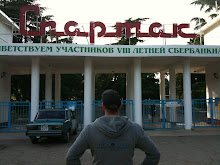
Re: Throwing intention and chambering your punches from your back muscles along the ulna-side o'dey arm.
I've been pondering that for everything I've seen on carpal tunnel, the injuries are on the "more recently developed" thumb-side. figures
Also, for the setup for shoulder-throw into armdrag we were doing yesterday: if you try to control the opp's wrist with your thumb-side, you get hung up. Whereas, if you just make a hook out of your pinky/ring&middle fingers against the palm of your hand and drive from your shoulder, your body tends to get out of its own way. I think because the ulna-side is push/shove oriented while the radius-side is pull/gather specific.
Why does this work? Well thanks to Vince Brown,
"what's happening is the thumb-side control of the wrist causes you to fire the upper traps and rhomboids so your scapula is unloaded from your trunk so the power is lost and thus, the hang up.
The radius-side is pull-gather in it's nature, but more specific toward pulling up towards our face for better looking.
The ulnar side is the route of pushing AND pulling power from the body. So if you make a hook with your pinky, ring and middle finger and drive the tip of the elbow down, the total force goes waaaay up."
This is why we love Vince^
I tell you guys what I've been told, "look at your watch" as you turn through the throw. If you get this right, everything else will follow. Your face and neck muscles are crucial to this movement. I know that looking thru helps bring your shoulder down and aligns every little freaking detail of the throw. Alex Barakov told us that even the small neck&jaw muscles were crucial to any throw of this type.
I now know (Vince again!) that it is "the sub-occipital complex. They have the highest density of muscle spindles per gram of any muscle in the body. They are neurologically wired to eye movement as well as to the erector spinea. So where the eyes look, the sub-o. senses it and prep the neck to support/move the head as well as get the back muscles ready for the direction change.
With the teeth together and the tongue at the roof of the mouth, this helps support/stabilize the spine. More neurologically than mechanically. Much like activating the pelvic floor assists in stabilizing the spine.
All those things together set the body up to be more cohesive, which allows for total commitment. Removes all the possible brakes to your motion."
Also included in this fireside chat, a great picture of Bob Gibson (studley MO-Fo big league pitcher) showing total commitment. He's famous for putting it all behind his pitch. I think he had an ERA of 1.19 or something in 1968. Notice that pitchers throw with their whole body, not the forefinger, thumb, bicep, deltiod...97 mph fastball comes from the feet up thru the hips and into the arm. The grip on the ball is the absolute last moment of contact. It's a question of priorities.
*pops open a nice cold one and tips it -thumb-side in- for a sip*
